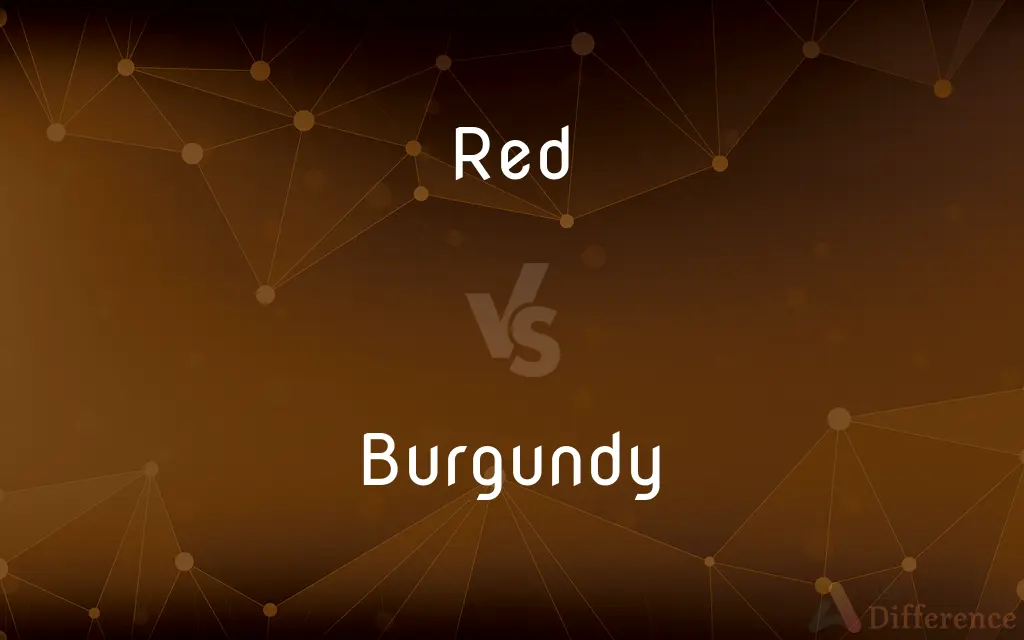Red vs. Burgundy — What's the Difference?
By Tayyaba Rehman — Updated on November 1, 2023
Red is a primary color on the visible spectrum; Burgundy is a dark red hue resembling red wine.

Difference Between Red and Burgundy
Table of Contents
ADVERTISEMENT
Key Differences
Red stands out as one of the three primary colors, foundational to various shades and hues in art and design. On the other hand, Burgundy is a specific shade that comes from the broader palette of red. While Red can be bright and attention-grabbing, Burgundy embodies a deeper, muted elegance, taking its name from wines produced in the Burgundy region of France.
Both Red and Burgundy are culturally significant. Red often symbolizes love, passion, danger, or power. Meanwhile, Burgundy, with its wine association, can evoke sophistication, depth, and luxury. This distinction in shades often influences their application in design, fashion, and branding.
In nature, Red is pervasive, found in flowers, fruits, and sometimes the sky at dawn or dusk. Burgundy, a more specific hue, is less common but can be seen in autumn leaves or some varieties of grapes. When describing objects or scenes, using "Burgundy" instead of "Red" can provide a more accurate and evocative imagery.
From a grammatical viewpoint, while "Red" is predominantly an adjective, it can also be a noun. "Burgundy," though primarily a noun when referencing the wine or region, can also be used as an adjective when describing the color. When comparing clothing items, one might say a "red shirt" or a "burgundy sweater."
Lastly, both Red and Burgundy have rich histories. Red has been used in art, symbolism, and culture for millennia, being one of the first colors used in prehistoric art. Burgundy's history is intertwined with wine-making, its name paying homage to the rich wine heritage of the Burgundy region.
ADVERTISEMENT
Comparison Chart
Basic Definition
A primary color
A shade of red resembling red wine
Symbolism
Love, passion, danger, power
Sophistication, depth, luxury
Occurrence in Nature
Flowers, fruits, sky
Autumn leaves, specific grape varieties
Grammatical Usage
Primarily an adjective, also noun
Primarily a noun (wine, region), also adjective
Historical Association
One of the earliest used colors
Wine heritage of the Burgundy region
Compare with Definitions
Red
A primary color in the visible spectrum.
She wore a bright red dress.
Burgundy
A shade of red resembling red wine.
Her burgundy scarf matched her lipstick.
Red
Symbolic of danger or caution.
Stop signs are red for visibility.
Burgundy
Indicative of autumnal scenes.
The burgundy leaves crunched underfoot.
Red
Indicative of financial loss.
The company was in the red this quarter.
Burgundy
A descriptor for deep, muted elegance in fashion.
He wore a burgundy suit to the evening gala.
Red
Red is the color at the long wavelength end of the visible spectrum of light, next to orange and opposite violet. It has a dominant wavelength of approximately 625–740 nanometres.
Burgundy
Relating to the wine produced in the Burgundy region of France.
He ordered a bottle of vintage Burgundy.
Red
The hue of the long-wavelength end of the visible spectrum, evoked in the human observer by radiant energy with wavelengths of approximately 630 to 750 nanometers; any of a group of colors that may vary in lightness and saturation and whose hue resembles that of blood; one of the additive or light primaries; one of the psychological primary hues.
Burgundy
Symbolizing sophistication or luxury.
The burgundy velvet curtains gave the room an opulent feel.
Red
A pigment or dye having a red hue.
Burgundy
Burgundy (; French: Bourgogne [buʁɡɔɲ] (listen)) is a historical territory and a former administrative region of east-central France. It is named for the Burgundians, an East Germanic people who moved westwards beyond the Rhine during the late Roman period.The name Burgundy has historically denoted numerous political entities, including kingdoms and duchies spanning territory from the Mediterranean to the Low Countries.
Red
Something that has a red hue.
Burgundy
A region and former duchy of east central France, centred on Dijon. The region is noted for its wine.
Red
Often Red A Communist.
Burgundy
Any of various red or white wines produced in the Burgundy region of France.
Red
A revolutionary activist.
Burgundy
Any of various similar wines produced elsewhere.
Red
The condition of being in debt or operating at a loss
The firm has been in the red all year.
Burgundy
Burgundy A dark grayish or blackish red to dark purplish red or reddish brown.
Red
Having a color resembling that of blood.
Burgundy
Alternative case form of Burgundy(red wine).
Red
Reddish in color or having parts that are reddish in color
A red dog.
A red oak.
Burgundy
(color) A dark red colour tinged with purple, like that of Burgundy (red) wine.
Red
Having a reddish or coppery skin color.
Burgundy
Of a deep purple red color like that of Burgundy wine.
Red
Often Red Often Offensive Of or being a Native American.
Burgundy
An old province of France (in the eastern central part).
Red
Having a ruddy or flushed complexion
Red with embarrassment.
Burgundy
A richly flavored wine, mostly red, made in Burgundy, France.
Red
Relating to or being a red state.
Burgundy
A former province of eastern France that is famous for its wines
Red
Often Red Communist.
Burgundy
Red table wine from the Burgundy region of France (or any similar wine made elsewhere)
Red
Having red#Noun as its color.
The girl wore a red skirt.
Burgundy
A dark purplish red to blackish red
Red
(of hair) Having an orange-brown or orange-blond colour; ginger.
Her hair had red highlights.
Red
(of the skin) With a red hue due to embarrassment or sunburn.
Red
Of the hearts or diamonds suits. Compare of the spades or clubs suits
I got two red queens, and he got one of the black queens.
Red
Supportive of, related to, or dominated by a political party or movement represented by the color red:
Red
Left-wing parties and movements, chiefly socialist or communist, including the U.K. Labour party and the Social Democratic Party of Germany.
The red-black grand coalition in Germany
Red
(US politics) The U.S. Republican Party.
A red state
A red Congress
Red
Amerind; relating to Amerindians or First Nations
Red
(astronomy) Of the lower-frequency region of the (typically visible) part of the electromagnetic spectrum which is relevant in the specific observation.
Red
(particle physics) Having a color charge of red.
Red
Any of a range of colours having the longest wavelengths, 670 nm, of the visible spectrum; a primary additive colour for transmitted light: the colour obtained by subtracting green and blue from white light using magenta and yellow filters; the colour of blood, ripe strawberries, etc.
Red can be seen as hot or angry.
Red
(countable) A revolutionary socialist or (most commonly) a Communist; usually capitalized a Bolshevik, a supporter of the Bolsheviks in the Russian Civil War.
Red
One of the 15 red balls used in snooker, distinguished from the colours.
Red
Red wine.
Red
(countable) Any of several varieties of ale which are brewed with red or kilned malt, giving the beer a red colour.
Red
A red kangaroo.
Red
A redshank.
Red
An American Indian.
Red
(slang) The drug secobarbital; a capsule of this drug.
Red
(informal) A red light a traffic signal
Red
(particle physics) One of the three color charges for quarks.
Red
Usually in the phrase "bowl of red".
Red
(informal) The redfish or red drum, Sciaenops ocellatus, a fish with reddish fins and scales.
Red
Tomato ketchup.
Red
(archaic) rede
Red
To put on order; to make tidy; also, to free from entanglement or embarrassement; - generally with up; as, to red up a house.
Red
Of the color of blood, or of a tint resembling that color; of the hue of that part of the rainbow, or of the solar spectrum, which is furthest from the violet part.
Your color, I warrant you, is as red as any rose.
Red
The color of blood, or of that part of the spectrum farthest from violet, or a tint resembling these.
Red
A red pigment.
Red
The menses.
Red
The quality or state of the chromatic color resembling the hue of blood
Red
A tributary of the Mississippi River that flows eastward from Texas along the southern boundary of Oklahoma and through Louisiana
Red
Emotionally charged terms used to refer to extreme radicals or revolutionaries
Red
The amount by which the cost of a business exceeds its revenue;
The company operated at a loss last year
The company operated in the red last year
Red
Having any of numerous bright or strong colors reminiscent of the color of blood or cherries or tomatoes or rubies
Red
Characterized by violence or bloodshed;
Writes of crimson deeds and barbaric days
Fann'd by Conquest's crimson wing
Convulsed with red rage
Red
(especially of the face) reddened or suffused with or as if with blood from emotion or exertion;
Crimson with fury
Turned red from exertion
With puffy reddened eyes
Red-faced and violent
Flushed (or crimson) with embarrassment
Red
Red with or characterized by blood;
Waving our red weapons o'er our heads
The Red Badge of Courage
The red rules of tooth and claw
Red
Associated with love or passion.
Red roses are a symbol of love.
Red
Relating to a political stance, especially communism.
The red flag was raised during the revolution.
Common Curiosities
Is Burgundy more muted than Red?
Yes, Burgundy is typically a deeper, more muted shade of red.
Is Burgundy a type of Red?
Yes, Burgundy is a specific shade of red, resembling red wine.
Why is the color named "Burgundy"?
It's named after the wines produced in the Burgundy region of France.
Can "Red" be used as a noun?
Yes, "Red" can be both an adjective (red apple) and a noun (the color red).
Which color is more commonly found in nature?
Red is more pervasive in nature, while Burgundy is specific to certain scenes, like autumn leaves.
Is Red a primary color?
Yes, Red is one of the three primary colors.
Is "Red" symbolic of love?
Yes, Red often symbolizes love, passion, and intensity.
Can "Burgundy" be used to describe items other than wine?
Absolutely, "Burgundy" can describe anything of that specific color, like clothing or decor.
Do both Red and Burgundy have historical significance?
Yes, while Red has ancient associations in art and culture, Burgundy's history is tied to winemaking.
Which color is brighter?
Red is generally brighter, while Burgundy is deeper and more muted.
Are there other colors similar to Burgundy?
Yes, maroon and oxblood are somewhat similar, but each has its unique hue.
Is Burgundy often associated with luxury?
Yes, due to its association with wine and its rich hue, it often evokes luxury and sophistication.
Can Red symbolize danger?
Yes, Red can symbolize danger, caution, or alertness.
Does Burgundy only refer to the color in the context of wine?
No, while it originates from the wine's color, "Burgundy" can describe anything of that hue.
Can both colors be used in fashion?
Absolutely, both Red and Burgundy are popular choices in fashion for different aesthetics.
Share Your Discovery

Previous Comparison
Objective vs. Subjective
Next Comparison
Extract vs. RaffinateAuthor Spotlight
Written by
Tayyaba RehmanTayyaba Rehman is a distinguished writer, currently serving as a primary contributor to askdifference.com. As a researcher in semantics and etymology, Tayyaba's passion for the complexity of languages and their distinctions has found a perfect home on the platform. Tayyaba delves into the intricacies of language, distinguishing between commonly confused words and phrases, thereby providing clarity for readers worldwide.














































